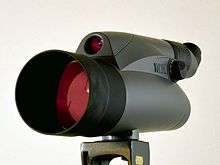Spotting scope


A spotting scope is a small portable telescope with added optics to present an erect image, optimized for the observation of terrestrial objects. They are used for birdwatching and other naturalist activities, for hunting, verifying a marksman's shots, ranging and surveillance, and for any other application that requires more magnification than a pair of binoculars, typically on the order of 20× to 60×.
The light-gathering power and resolution of a spotting scope is determined by the diameter of the objective lens, typically between 50 and 80 mm (2.0 and 3.1 in). The larger the objective, the more massive and expensive the telescope.
The optical assembly has a small refracting objective lens, an image erecting system that uses either image erecting relay lenses or prisms (Porro prisms or roof prisms), and an eyepiece that is usually removable and interchangeable to give different magnifications. Other telescope designs are used such as Schmidt and Maksutov optical assemblies. They may have a ruggedised design, a mounting for attaching to a tripod, and an ergonomically designed and located knob for focus control.
Eyepieces are usually interchangeable to give different magnifications, or may consist of a single variable "zoom" eyepiece to give a range of magnifications. Magnifications of less than 20× are unusual, as are magnifications of more than 60× since it can lead to poorer image brightness, a narrow field of view, and show too much image shake, even on a tripod. The eyepiece mount layout can be "straight-through" (the eyepiece is on the same axis as the body of the scope), or "angled" (the eyepiece is at an angle of usually 45 degrees to the body of the scope).
See also
- Milliradian, a measurement used in scope reticles intended for shooting
- Digiscoping
- List of telescope types